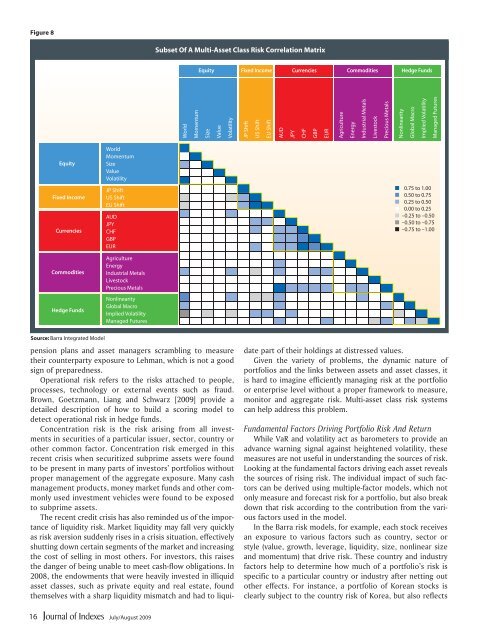How to Kill a Black Swan Remy Briand and David Owyong ...
How to Kill a Black Swan Remy Briand and David Owyong ...
How to Kill a Black Swan Remy Briand and David Owyong ...
You also want an ePaper? Increase the reach of your titles
YUMPU automatically turns print PDFs into web optimized ePapers that Google loves.
Figure 8<br />
Subset Of A Multi-Asset Class Risk Correlation Matrix<br />
Equity<br />
Fixed Income Currencies Commodities Hedge Funds<br />
World<br />
Momentum<br />
Size<br />
Value<br />
Volatility<br />
JP Shift<br />
US Shift<br />
EU Shift<br />
AUD<br />
JPY<br />
CHF<br />
GBP<br />
EUR<br />
Agriculture<br />
Energy<br />
Industrial Metals<br />
Lives<strong>to</strong>ck<br />
Precious Metals<br />
Nonlinearity<br />
Global Macro<br />
Implied Volatility<br />
Managed Futures<br />
Equity<br />
Fixed Income<br />
Currencies<br />
Commodities<br />
Hedge Funds<br />
World<br />
Momentum<br />
Size<br />
Value<br />
Volatility<br />
JP Shift<br />
US Shift<br />
EU Shift<br />
AUD<br />
JPY<br />
CHF<br />
GBP<br />
EUR<br />
Agriculture<br />
Energy<br />
Industrial Metals<br />
Lives<strong>to</strong>ck<br />
Precious Metals<br />
Nonlinearity<br />
Global Macro<br />
Implied Volatility<br />
Managed Futures<br />
Source: Barra Integrated Model<br />
pension plans <strong>and</strong> asset managers scrambling <strong>to</strong> measure<br />
their counterparty exposure <strong>to</strong> Lehman, which is not a good<br />
sign of preparedness.<br />
Operational risk refers <strong>to</strong> the risks attached <strong>to</strong> people,<br />
processes, technology or external events such as fraud.<br />
Brown, Goetzmann, Liang <strong>and</strong> Schwarz [2009] provide a<br />
detailed description of how <strong>to</strong> build a scoring model <strong>to</strong><br />
detect operational risk in hedge funds.<br />
Concentration risk is the risk arising from all investments<br />
in securities of a particular issuer, sec<strong>to</strong>r, country or<br />
other common fac<strong>to</strong>r. Concentration risk emerged in this<br />
recent crisis when securitized subprime assets were found<br />
<strong>to</strong> be present in many parts of inves<strong>to</strong>rs’ portfolios without<br />
proper management of the aggregate exposure. Many cash<br />
management products, money market funds <strong>and</strong> other commonly<br />
used investment vehicles were found <strong>to</strong> be exposed<br />
<strong>to</strong> subprime assets.<br />
The recent credit crisis has also reminded us of the importance<br />
of liquidity risk. Market liquidity may fall very quickly<br />
as risk aversion suddenly rises in a crisis situation, effectively<br />
shutting down certain segments of the market <strong>and</strong> increasing<br />
the cost of selling in most others. For inves<strong>to</strong>rs, this raises<br />
the danger of being unable <strong>to</strong> meet cash-flow obligations. In<br />
2008, the endowments that were heavily invested in illiquid<br />
asset classes, such as private equity <strong>and</strong> real estate, found<br />
themselves with a sharp liquidity mismatch <strong>and</strong> had <strong>to</strong> liquidate<br />
part of their holdings at distressed values.<br />
Given the variety of problems, the dynamic nature of<br />
portfolios <strong>and</strong> the links between assets <strong>and</strong> asset classes, it<br />
is hard <strong>to</strong> imagine efficiently managing risk at the portfolio<br />
or enterprise level without a proper framework <strong>to</strong> measure,<br />
moni<strong>to</strong>r <strong>and</strong> aggregate risk. Multi-asset class risk systems<br />
can help address this problem.<br />
Fundamental Fac<strong>to</strong>rs Driving Portfolio Risk And Return<br />
While VaR <strong>and</strong> volatility act as barometers <strong>to</strong> provide an<br />
advance warning signal against heightened volatility, these<br />
measures are not useful in underst<strong>and</strong>ing the sources of risk.<br />
Looking at the fundamental fac<strong>to</strong>rs driving each asset reveals<br />
the sources of rising risk. The individual impact of such fac<strong>to</strong>rs<br />
can be derived using multiple-fac<strong>to</strong>r models, which not<br />
only measure <strong>and</strong> forecast risk for a portfolio, but also break<br />
down that risk according <strong>to</strong> the contribution from the various<br />
fac<strong>to</strong>rs used in the model.<br />
In the Barra risk models, for example, each s<strong>to</strong>ck receives<br />
an exposure <strong>to</strong> various fac<strong>to</strong>rs such as country, sec<strong>to</strong>r or<br />
style (value, growth, leverage, liquidity, size, nonlinear size<br />
<strong>and</strong> momentum) that drive risk. These country <strong>and</strong> industry<br />
fac<strong>to</strong>rs help <strong>to</strong> determine how much of a portfolio’s risk is<br />
specific <strong>to</strong> a particular country or industry after netting out<br />
other effects. For instance, a portfolio of Korean s<strong>to</strong>cks is<br />
clearly subject <strong>to</strong> the country risk of Korea, but also reflects<br />
16<br />
July/August 2009
















